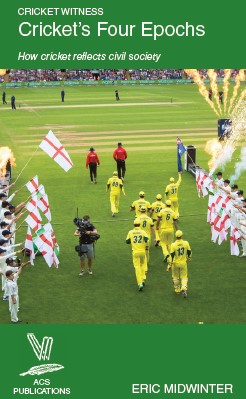Cricket’s Four Epochs: How Cricket Reflects Civil Society
Martin Chandler |Published: 2021
Pages: 139
Author: Midwinter, Eric
Publisher: ACS
Rating: 3.5 stars

The blurb to Eric Midwinter’s latest book begins:-
Does the style and timbre of cricket change in accordance with similar shifts in society? This trail-blazing text answers the question positively in arguing that mainstream English cricket has, over the last 300 years, undergone three incarnations – and is maybe heading for a fourth – each in approach and tone, a manifestation of the prevailing political economy and culture.
Which I have to say in isolation suggests that the book is at best somewhat esoteric, and at worst simply self-indulgent. Ordinarily I wouldn’t have gone any further, but Midwinter’s name sways that one. He is a first rate social historian as well as an accomplished cricket historian, and I don’t ever recall reading any of his writings that didn’t leave me with the feeling that I had spent my time wisely.
So it was hardly unexpected that Cricket’s Four Epochs is worth a read. Books that try to place cricket in the context of society are not in themselves unusual, but this one adopts what is certainly a different approach. The four epochs are looked at in a broad brush manner and Midwinter looks, for each of the periods he selects, at the way society and cricket developed, before arriving at his overall assessment.
The conclusion for the first epoch is that society and cricket were individualist. The period is from 1720 to 1830 and saw the game as very much a private enterprise arranged in such a way as to provide profit. Society generally was very much the same. There is not a great deal of cricket writing in relation to this first epoch, but it was illuminating to be able to put into context important episodes in English history that, prior to reading Midwinter’s analysis, I had heard of but not fully appreciated. Examples are the South Sea Bubble, the Spitalfields Riots and the Black Act of 1923.
There is rather more cricket in the second epoch, from 1830-1960. Society developed a conscience and began to look after its weak and vulnerable, a trend that continued throughout the period. As for cricket our great game became a sport as much as an enterprise, giving entertainment and pleasure to the many rather than commercial opportunities for the few. Midwinter describes this as collectivism.
The third epoch stretches from 1960 to 2030, coincidentally the period of my lifetime. I have to admit that Midwinter is spot on with his analysis here. The advent of Thatcherism and the economic and personal freedoms that have accompanied it have indeed demonstrated a return to individualism. Cricket, deep in a rut of its own making by 1960, has seen new shorter formats introduced, and the potential earnings of the top players in the present day most certainly share all of the same individualist characteristics as wider society.
Which brings us to the future, and something that by definition Midwinter has no knowledge of. It is something we all have an opinion on and Midwinter duly expresses his. Experience, training and knowledge mean however that his views are authoritative, and the chapter analysing the years ahead is, perhaps inevitably, the book’s most interesting. The climate crisis and global pandemic have and will continue to bring about great change, and Midwinter foresees a societal return to collectivism. He sees cricket’s future taking a similar path which, in some ways, is reassuring, although his predictions as to the structure of the domestic game in England in 2047 will be of concern to many.
To go into any more detail about Cricket’s Four Epochs: How Cricket Reflects Civil Society would risk playing spoiler, which I think would be unhelpful, so I will conclude simply by confirming this one is an absorbing and thought provoking read.
*This review first appeared in the Spring 2022 edition of the ACS Journal. Memberships and a subscription to the journal can be secured here






Leave a comment